Physical Address
304 North Cardinal St.
Dorchester Center, MA 02124
Careful preoperative planning, along with pharmacologic consultation, is essential for optimal results in obese patients undergoing total hip arthroplasty (THA).
Early postoperative mobilization, although possibly more difficult for obese patients, is critical to avoid decline in function as well as thromboembolic and respiratory complications.
Intraoperative radiographic evaluation is important in obese THA patients to assist the surgeon in attaining proper acetabular cup placement and leg length equality.
Prolonged wound drainage, higher rates of infection, dislocation, aseptic loosening of implants, deep venous thrombosis, and increased intraoperative time are known risks for obese patients undergoing THA.
Higher complication rates among obese patients undergoing THA may be reduced if patients lose weight, undergo bariatric surgery, improve nutritional status, or increase muscle strength before THA.
Recent data (2014) from the World Health Organization (WHO) estimate that approximately 1.9 billion people age 18 years and older are overweight (i.e., body mass index [BMI] ≥ 25; Table 86.1 ) and that at least 600 million people worldwide are obese (i.e., BMI ≥ 30). Between 2007 and 2008, the number of people in the United States in the overweight category grew to a staggering 72.3% of the entire population, with over 32% falling in the obese category. In the orthopedic total joint arthroplasty practice, this number has been reported to be even higher, with recent studies reporting that up to 55% of all presenting patients are obese. It is estimated that the medical burden of obesity is responsible for nearly 10% of all medical spending in the United States. Total hip arthroplasty (THA) in obese patients presents the surgeon with challenges associated with the surgical procedure itself, the increased risk of perioperative complications, postoperative recovery, and performance of the implant. This chapter will focus on those aspects of THA performed in patients with high BMI ( Table 86.2 ).
| Classification | BMI, kg/m 2 | |
|---|---|---|
| Principal Cutoff Points | Additional Cutoff Points | |
| Underweight | < 18.50 | < 18.50 |
| Severe thinness | < 16.00 | < 16.00 |
| Moderate thinness | 16.00–16.99 | 16.00–16.99 |
| Mild thinness | 17.00–18.49 | 17.00–18.49 |
| Normal range | 18.50–24.99 | 18.50–22.99 |
| 23.00–24.99 | ||
| Overweight | ≥ 25.00 | ≥ 25.00 |
| Preobese | 25.00–29.99 | 25.00–27.49 |
| 27.50–29.99 | ||
| Obese | ≥ 30.00 | ≥ 30.00 |
|
30.00–34.99 | 30.00–32.49 |
| 32.50–34.99 | ||
|
35.00–39.99 | 35.00–37.49 |
| 37.50–39.99 | ||
|
≥ 40.00 | ≥ 40.00 |
| Study (Year) | Design | Comparison (No. Hips) | Outcomes/Variables | Authors’ Conclusions | Authors’ Limitations |
|---|---|---|---|---|---|
| Deakin et al. (2017) | Retrospective | 906 THAs divided into three BMI groups | Hospital LOS, OHSs, complication rates | Obese and nonobese patients have similar outcomes, but morbid obesity results in decreased outcomes and increased complications. | Small study population, no preoperative scores |
| McLawhorn et al. (2017) | Retrospective review | 2733 THAs | EQ-5D-3L index, EQ-VAS, HRQoL scores | Obese patients have lower absolute HRQoL scores but proportionally similar improvements in scores postoperatively. | Single institution, BMI sometimes is a poor measure of obesity |
| Malinzak et al. (2009) | Retrospective | Deep infection (13)/noninfected (2775) | BMI, diabetes, osteoarthritis, rheumatoid | Obesity, diabetes, younger age risk factors for joint arthroplasty infection | Retrospective, nonidentical perioperative management |
| Andrew et al. (2008) | Prospective, multicenter | Nonobese (1069)/obese (332)/morbidly obese (18) | OHS, rate of dislocation, blood transfusion, deep infection, DVT, PE, revision | No significant difference between groups for mean change in OHS at 5 years, rate of dislocation, or rate of revision | Only 18 morbidly obese patients |
| Walsh et al. (2009) | Retrospective | PE (30)/no PE (5755) | Age, BMI, gender, ASA grade, physical activity level, DVT prophylaxis | Increasing age, increased BMI, female gender associated with increased risk of PE. | Multicenter study may allow acquisition of more PE cases, which should allow for study of various DVT prophylaxis regimens and other risk factors. |
| Fehring et al. (2007) | Retrospective | Increases in BMI 1990–2005 (number of cases not given) | BMI increase, Medicare reimbursement | BMI of total joint arthroplasty patients has increased significantly over time; reimbursement has not kept pace. | As a tertiary referral center, may receive more obese patients from referral. |
| Lübbeke et al. (2007) | Prospective cohort study | Nonobese (1906)/obese (589)/men vs. women | Main complications, HHS, WOMAC | Obesity increased infection rate in women (not in men); functional outcome and satisfaction slightly lower in obese women; no difference among men. | Lack of information about patients’ activity level, small number of revisions, short follow-up time |
| Patel et al. (2007) | Retrospective | Nonobese/obese (total, 1211) | BMI, blood loss, operative time, prophylaxis against DVT, LOS, duration of wound drainage | Morbid obesity, low-molecular-weight heparin, greater wound drainage were associated with prolonged wound drainage; prolonged drainage was associated with a higher rate of infection. | None stated |
| McLaughlin and Lee (2006) | Retrospective | Nonobese (100)/obese (109) | BMI, revisions, perioperative complications, HHS | No difference between groups in clinical and radiologic outcomes, complications, or revisions. | None stated |
| Sadr Azodi et al. (2006) | Retrospective | Nonobese (1167)/ overweight and obese (2142); tobacco use vs. no tobacco use | LOS, complications | Smoking and obesity substantially increase risk of complications; high BMI was statistically significantly correlated with longer hospital stay. | Data obtained from registry; data may be missing or incomplete. |
| Moran et al. (2005) | Prospective | BMI (800) | HHS, SF-36; reoperation, death, dislocation, deep/superficial infection | No relationship between BMI and any complications found; BMI predicted slightly lower HHS at 6 and 18 months. | Power of the study may be too low. |
| Ibrahim et al. (2005) | Retrospective | Nonobese (179)/obese (164) | Complications/reoperation/self-administered questionnaire for satisfaction | No difference in satisfaction between nonobese and obese; no significant difference in complications or revision surgery; at minimum 1-year follow-up, BMI > 30 is not associated with an increase in complications or reoperation. | Short follow-up period; complications assessed subjectively by patient questionnaire. |
| Mantilla et al. (2003) | Case control | PE (116)/no PE (116) | BMI, ASA grade, prophylaxis against thromboembolic events | In patients undergoing lower extremity arthroplasty, obesity, poor ASA grade, lack of thromboprophylaxis are independent risk factors for thromboembolic events. | Findings show relative risk is greater than absolute risk. |
| Stürmer et al. (2002) | Retrospective | Smoking, drinking, obesity (10,000) | 17 common chronic health conditions; SF-12; spending on inpatient and ambulatory care; medication use | Obesity has significantly greater effects on chronic conditions and causes a greater increase in patient care costs than are seen with smoking. | None stated |
| Stickles et al. (2001) | Retrospective | BMI < 25 (131); 25–30 (223); 30–35 (119); 35–40 (51); > 40 (27) | Patient satisfaction, complications; WOMAC and SF-36 | No difference between obese and nonobese patients in satisfaction, decision to undergo THA again; slightly increased risk for complications among obese. | Only ≈24% of preoperative data are usable because patients were excluded if no 1-year follow-up data were available. |
| White et al. (2000) | Retrospective | Rehospitalization for thromboembolism after THA (297)/ unmatched controls (592) | Demographic, surgical, medical; BMI | BMI ≥ 25 associated with rehospitalization for thromboembolism | Diagnostic bias and selection bias |
| Chan and Villar (1996) | Prospective | Nonobese (85)/obese (81) | Preoperative and postoperative quality of life; modified HHS and Rosser Index Matrix | No significant difference in quality of life scores at 1 and 3 years; relative body weight alone does not influence the benefits of THA. | None stated |
| Jiganti et al. (1993) | Retrospective | Nonobese (270)/obese (41) | Complications | No significant differences between nonobese and obese patients. | More rheumatoid patients in nonobese group (steroids could affect wound healing and infection rates, thus increasing complications). |
The most common indication for THA is osteoarthritis (OA). Several studies have shown that obesity is likely to play a role in the development of OA of the hip. Clinicians have postulated that “obese” (BMI, 30–39.9 kg/m 2 ) and “morbidly obese” (i.e., BMI ≥ 40 kg/m 2 ) patients undergoing THA pose greater technical difficulty for the surgeon, have more postoperative complications, and have poorer short- and long-term outcomes than “ideal weight” (BMI, 20–24.9 kg/m 2 ) or “overweight” (BMI, 25–29.9 kg/m 2 ) patients. In 1982, Sir John Charnley stated that obesity should be a contraindication to performing THA. Some surgeons advise obese patients to lose weight before undergoing THA, believing that THA in an obese patient would be technically demanding and would likely lead to increased postoperative morbidity. Possible concerns have included increased risk of infection, thromboembolism, and early implant failure (e.g., aseptic loosening, fatigue fracture).
Implant manufacturers today include some patient selection caveats in their precautionary statements to surgeons and include warnings in their product inserts, for example: “patients should be able to control their weight,” “excessive weight may adversely affect the implant,” “heavy patients can place high loads on the prosthesis which may lead to failure,” and “complications or failure may be more likely in heavy patients.” A study by Craik et al. found that 16% of 147,691 obese THA patients received implants against manufacturer recommendations that specifically listed obesity as a contraindication.
Some surgeons postulate that obesity should not be a deterrent to THA, with several studies reporting excellent functional outcomes, pain relief, and quality of life comparable to those seen in normal BMI patients. Regardless, a thorough discussion with the patient about the risks of THA and obesity is key.
Preoperative planning for obese patients does not differ, in general, from planning for nonobese patients. Standard radiographic imaging should be performed. A radiographic marker may be more important for sizing because of increased distance between the hip and the radiographic plate. For those who prefer it, digital templating has been shown to be effective at predicting THA component sizes regardless of BMI. To facilitate postoperative evaluation and long-term follow-up, additional preoperative assessments can be valuable, for example, Harris Hip Scores (HHSs), the 12-Item Short Form Health Survey (SF-12) or 36-Item Short Form Health Survey (SF-36), HgA1c, percent body fat, albumin, and grip strength.
It is advisable to encourage obese patients to attempt to increase upper body strength preoperatively because they must use an overhead frame on the hospital bed to assist in achieving early mobilization. As with all THA procedures, early mobilization is important to avoid an overall decline in function, venous thromboembolism, and respiratory complications. In addition, preoperative plans for other accommodative equipment should be made, such as a wide bedside commode and a wide walker. Preoperative planning should also include pharmacologic consultation to ensure careful administration of narcotic pain medications because obese patients often cannot tolerate as much narcotic medication as simple calculations based on an increased BMI might suggest. Finally, consideration should be given to bariatric surgery and weight loss before elective primary THA for selected patients.
The effectiveness of bariatric surgery prior to THA is a hotly debated topic. Multiple studies have reported decreased complication rates and improved functional outcomes with preoperative bariatric surgery and weight loss; however, these are mostly retrospective studies, and there are conflicting reports. A study performed through the US Veterans Health Administration reported significantly less weight loss after bariatric surgery in patients who had OA. Nearing and Santos performed a retrospective review of all bariatric surgery patients from 2001 to 2014 and found that BMI was lower for those undergoing THA after bariatric surgery compared with those before surgery and that operative time and length of stay (LOS) were significantly decreased for THA performed after bariatric surgery (81.7 vs. 117 minutes, p < 0.001; and 2.9 vs. 3.8 days, p < 0.001, respectively). Often in the clinic setting, patients will state that they cannot lose weight because of the joint pain and associated decreased activity levels. Hurwit and Cross demonstrated that 73% of high BMI patients maintain their same weight postoperatively, though females were more likely to lose weight. Natural weight loss through diet and exercise should be encouraged preoperatively in all obese patients and bariatric surgery considered in higher BMI categories.
Few differences in operative technique have been described for obese patients undergoing THA. In general, a minimally invasive approach should be avoided in obese patients; however, any approach and incision that can achieve easy and adequate exposure while protecting the soft tissues is appropriate ( Fig. 86.1 ). The author prefers a straight lateral position on the operating table, which allows fat/excess skin to “fall away” ( Figs. 86.2 through 86.5 ), combined with an anterolateral or posterior approach and a cementless socket and stem. Several studies report increased surgical wound complications for the direct anterior approach (DAA) for THA, especially in obese patients. Therefore, it may not be ideal in these patients. Purcell et al., however, recently published a new and larger retrospective study showing no difference in superficial or deep infection rates between DAA and posterior approach (PA) hips in obese patients. For obese patients, a low-wear bearing with large diameter head is preferred in the absence of other contraindications. Dual-mobility implants should be considered in patients for whom instability is a concern.
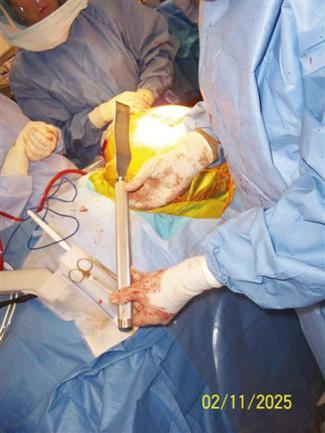
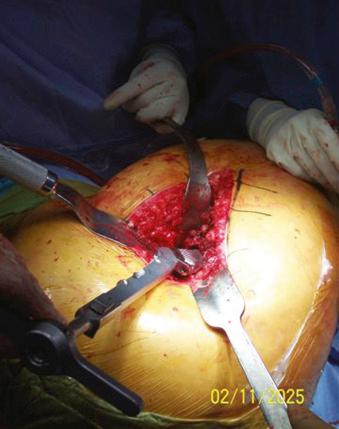
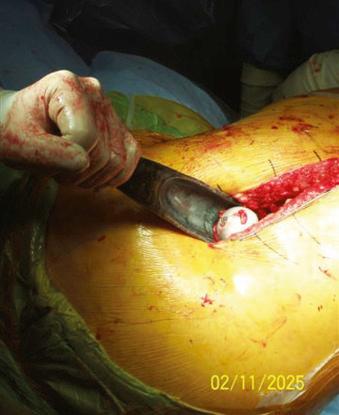
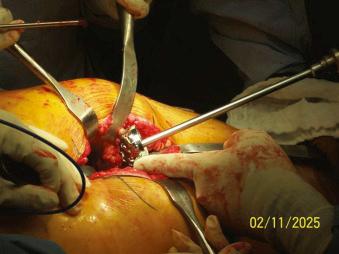
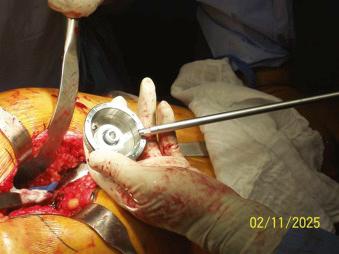
Intraoperative radiographic evaluation allows the surgeon to determine proper cup placement. A study by Lambers and Jennings that tracked acetabular cup placement accuracy without fluoroscopy followed by immediate reposition of cups after imaging found that 57% of patients had an error of 5 degrees or more in at least one plane. A large retrospective study by Gosthe and Suarez recently demonstrated that with fluoroscopic guidance, acetabular components can be placed with accuracy comparable to those placed in nonobese patients. With obese patients, a tendency to place the cup in a more abducted position in the acetabulum should be avoided because this may result in increased wear. Similarly, strong traction caused by retractors in obese patients can lead to iatrogenic pelvic lift. It is recommended to release retractors prior to impacting the acetabular cup to allow the pelvis to tilt back to its neutral position if using a lateral transgluteal approach. Intraoperative radiographs allow the surgeon to assess the equality of leg length, which can be more difficult to determine in obese patients. At the conclusion of the operation, two drains are placed: one deep to the fascia and the other in the subcutaneous space. Then, a waterproof, occlusive dressing is applied in an effort to reduce wound complications and promote wound healing ( Fig. 86.6 ).
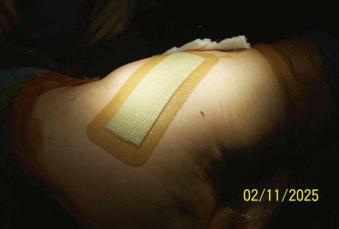
Become a Clinical Tree membership for Full access and enjoy Unlimited articles
If you are a member. Log in here